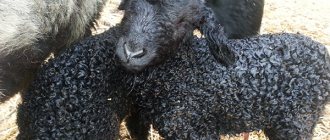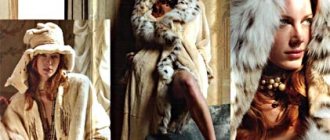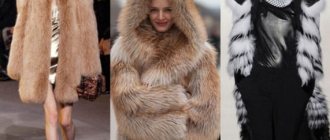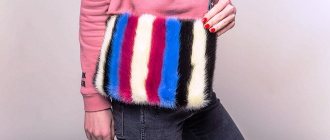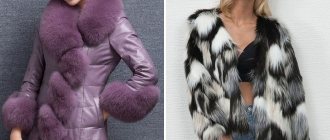At all times, fur products were worth their weight in gold. A fur coat not only protected its owner from bad weather, but also testified to financial well-being and importance in society. Karakul gained popularity at the end of the 19th century and is still found in the collections of leading clothing designers. This fur is represented by many types, the most famous of which are astrakhan fur and broadtail.
History of the origin of karakul
The Karakul sheep was one of the first animals that people started breeding for their fur. The animal was distinguished not only by its beautiful fur, but also by its special unpretentiousness, which allowed it to perfectly adapt to the difficult living conditions in the desert.
The ancestor of all Karakul sheep comes from Uzbekistan, in the past – the Khorezm Khanate. The name of the fur also comes from those places. Translated into Russian, “karakul” means “black lake”. It was near this reservoir, located near Bukhara, that Karakul sheep began to be bred.
For many years, the right to breed these animals and produce expensive and beautiful fur belonged exclusively to the Bukhara Khan. And only many years later, already at the beginning of the 20th century, several individuals were sent to North Africa, in particular Namibia, where today, thanks to new technologies, a special type of karakul called “svakara” is made.
Karakul and broadtail - what's the difference?
It is known that karakul is made from the skins of newly born lambs of the karakul breed. For this process, individuals 1–3 days old are used. After all, the older the lamb, the coarser the wool. Each skin surprises with its special unique pattern, extraordinary lightness and silkiness.
However, not every person who is not involved in fur production issues will correctly answer the question: broadtail - whose fur?
Karakulcha is the same skins of lambs, but not yet born. It is not difficult to distinguish it from astrakhan fur: the curls are not yet formed, the hairs are short and tightly adjacent to each other, the skin has a beautiful moire pattern.
These two types of fur differ not only in origin, but also in consumer characteristics.
| Characteristics | Astrakhan | Broadtail |
| Appearance | The fur is dense, the curls are clear and fully formed. There is fur of silver, golden, black color. The rarest colors are brown and white. The skin is silky and very soft to the touch. | Unique moire pattern, not fully formed curl. The skins are small in size. Color black, gold or silver. |
| Thermal conductivity | Thanks to the dense core, it retains heat well and is not afraid of moisture. Excellent protection from the cold if the frost is not lower than -10°C. | The density of broadtail is much lower, so products made from this material are not suitable for wearing in winter. |
| Wear resistance | Durable material, excellently withstands use for 10 seasons. Fur is not wear-resistant. | Clothing made from astrakhan fur lasts no more than three years. |
| Usage | Coats and jackets, collars, men's and women's hats are made from astrakhan fur. | It is used for light coats and jackets, but most often as a trim for dresses, coats, and suits. Usually these are exclusive products intended for publication. |
Types of fur raw materials obtained from the Karakul breed
How is karakul made and what are the types of karakul? The following types of fur raw materials are known, which can be obtained from unborn or newborn lambs:
- Smushka is the skin from a Smushka sheep from four-day-old lambs. It is distinguished by its softness, matte and shiny structure, loose and braided curls.
- Moire is a canvas with a moire pattern and low hairline.
- Klyam is a canvas that has a low raised cover with manes and a moiré pattern.
- Merlushka is a soft, coarse wool, glassy-shiny and matte, on which curls of various shapes are formed.
- Webbing is a cover consisting of ring-shaped curls.
- Treasok and sak-sak - a cover consisting of ring-shaped and corkscrew-shaped curls. Has a silky texture.
- Golyak - skins with barely visible wool from four-month abortions and embryos of sheep.
- Kurakulcha - skins of four-month-old embryos.
- Yahobab - skins of one-month-old lambs that were obtained during forced slaughter.
- Treasok is the wool of six-month-old lambs.
Attention ! It is also obtained from the Karakul breed of sheepskin - the skins of adult animals. It is often dry and friable.
Golyak
Types of karakul
Breeders involved in karakul breeding strive to consistently obtain large batches of identical skins that have the specified parameters and characteristics. It is not so easy. After all, the quality of scribble is determined by at least twenty parameters. In addition, fashion dictates its terms, constantly changing the demand for astrakhan of various types and shades. Today, three types of karakul are dominant on the market.
Uzbek karakul
The breed of sheep that supplies this fur was bred by specialists from Uzbekistan. Breeders tried to achieve lightness of fur, relying on the finest astrakhan jacket type with a special pattern. The surface of the skin consists of tight fur curls, forming tubular ridges of varying lengths.
Pros:
- unique design;
- thin light fur;
- fur hairs are pressed tightly against each other;
- strong flesh;
- affordable price.
Minus:
- small size of skins (11 dts2).
Afghan karakul (astragan)
This karakul is produced in Afghanistan. Thick fur of the highest quality is valued much higher than Uzbek fur. Skins usually range in size from 12 to 20 dt2. The fur surface is ribbed and flat, with an extraordinary eye-catching shine. Typically, Afghan karakul has a deep gray tint.
Pros:
- mesmerizing shine;
- thick flesh;
- high strength;
- large skins;
- spectacular fur.
Minus:
- heavy weight of the product.
South African karakul - swakara
This type of karakul is produced in the state of Namibia on the African continent. The surface of the fur is distinguished by amazingly clear parallel flat curls. The skins are canvases similar in thickness to broadtail.
Namibian karakul is the most expensive. It is mainly used to make fashionable coats and jackets for special occasions.
Pros:
- clear ribbed pattern;
- ease;
- small thickness;
- respectability.
Minus:
- high price.
Any high quality scribble is highly appreciated. However, swakara is considered the most expensive and prestigious fur, which not everyone can afford.
Disadvantages of a swakara fur coat
Among such an abundance of advantages of the South African karakul, there was a fly in the ointment. The main disadvantage of this fur is its high cost.
There are few craftsmen who are ready to engage in breeding work, as well as processing such delicate fur. For this reason, the number of swakara fur coats is quite limited and distributed in meager quantities. Despite this, it still remains very popular, outpacing the sales rankings of Afghan astrakhan and broadtail.
Features of doodle
Astrakhan fur is distinguished by its unique texture, thickness and silkiness. Any product made from this natural material is unique, since the pattern of curls cannot be repeated. Things made from astrakhan fur look graceful and elegant, and also perfectly repel moisture. Light and warm, they allow air to pass through perfectly, and are as durable as regular sheepskin.
The main advantages of karakul:
- plastic material allows you to create a variety of models;
- ideal for decorating products;
- goes well with fabric and leather;
- allows you to create sophisticated and elegant clothes;
- Astrakhan products are suitable for any figure.
Winter clothing made from astrakhan fur is light and warm, but without special insulation it is hardly suitable for the harsh Russian winter. These are clothes most likely for the off-season, when outside the window is at least -10°C.
Swakara fur coat models and their prices
Masters of swakara processing are highly valued among designers and fashion designers. Entire queues line up to see truly skilled specialists, because only from high-quality processed material are they sewn into a wide variety of fur coat models.
Note: The most popular model among young people is the trapezoidal silhouette of a medium-length fur coat. In such specimens the sleeve is usually in the form of moth wings.
Older ladies prefer classic models, as well as models with flared hems. This model is called the “bell”. The model with the no less beautiful name “ballet shoe” has a flared back and, as a rule, is never too short.
Today, astrakhan coats are decorated with a large number of different elements. First of all, these are collars (most often English), patch pockets made of another type of fur (usually long-haired) and belts.
From swakara, as well as from astrakhan and astrakhan fur, they sew:
1. fur coats-cocoons; 2. fur coats; 4. combined models; 5. models complemented by collars/hoods.
[Show slideshow]
Rules for caring for things made from astrakhan fur
The durability and respectable appearance of the product over the years depends on proper care and compliance with storage conditions in the summer. If your fur coat is significantly dirty, it is better to use the services of a specialized dry cleaner. However, it is quite possible to get rid of small stains and dust at home.
Here are some recommendations for caring for an astrakhan fur coat or coat:
- The surface of astrakhan or broadtail can be wiped with a sponge dipped in a soap solution.
- To remove dust, the product is laid out on a slightly damp sheet with the wrong side up and knocked out with rolled paper or a special plastic beater.
- By wiping the surface of the fur with a cotton pad soaked in a 5% vinegar solution, you can restore the original shine and silkiness.
- Contaminated areas are treated with starch. The greasy stain is covered with powder, lightly rubbed into the pile, and then cleaned with a clothes brush.
- To avoid creases and bald spots, it is not recommended to carry a bag on your shoulder or leave a brooch pinned in one place for a long time.
Under no circumstances should you wash, iron or comb the astrakhan fur. This will inevitably lead to damage to the product.
Distinctive features
Karakul is the skin of a newborn lamb. An important condition is the age of the animal; it should not be more than three days old. This period is characterized by special thickness, elasticity and silkiness of the hair. Curls are formed on the skin, differing in shape and size; they can be rolled, bean-shaped, etc.
The skin of a premature lamb is called broadtail. This fur is distinguished by its thinness, it stretches well, and has short, thick fur. The skin is shiny, has a moiré pattern, the curls are not clearly formed, and the tactile sensation is similar to velvet.
Despite the weak strength of broadtail, it is considered quite valuable, beautiful and expensive.
Questions and answers
How to revive an astrakhan fur coat after a walk in wet snow?
If a fur coat made of astrakhan fur or astrakhan fur gets wet, it must be shaken off, ridding the fur of moisture and snow, and then hung on hangers to dry. Do not dry fur items near heating devices or under a hairdryer. Sudden temperature changes can lead to deformation and damage to clothing.
How to store products made from astrakhan fur or astrakhan fur?
As soon as the winter season is over, the astrakhan fur coat or coat is put away in the closet. The product is hung on wide soft hangers, and a fabric cover is put on top. A continuous supply of fresh air is very important for fur, so the fur coat should hang freely. In addition, care must be taken to protect against moths.
How to choose?
For women, shopping is their mission. Choosing a quality fur coat is very difficult. They repeat one mistake: they pay attention only to the external qualities of outerwear. Beautiful or ugly, but this is not the criterion that should play a decisive role.
Tips for women who are planning to purchase a fur coat from Afghan astrakhan fur:
- Pay attention to the seams (they should be noticeable and clear);
- Take a piece of another woolen fabric. Then rub the fur, if it begins to fray (at least one lint falls out), it means the product is of poor quality, most likely the skin was removed in the autumn (when animals shed);
- The color of the fur coat should not be dull;
- The fur coat should fit your size. For example, if you wear size 48, it is better to take a fur coat of size 50, because in winter you will wear warm clothes, and the fur coat should not be tight and restrict movement;
- The fur should be pleasant to the body, do not be shy, bring the fur coat to your face;
- Do not take a fur coat with a long hem, as over time the hem will wear out;
- Ask the seller for manufacturer information.
[Show slideshow]
How to store?
In order for an astrakhan fur coat to serve you as long as possible and not lose its presentability after several seasons, it must be stored correctly.
- Be sure to clean the fur product from dirt.
- Buy hangers with soft pads and provide plenty of free space in your closet for fur coats.
- Do not allow other outer clothing to press down on the product (the fibers may be damaged).
- It is strictly not recommended to store furs on the balcony, where the sun's rays fall.
- Also think about the pier. It is everywhere, put a flavored tablet that will prevent insects from getting inside. How to properly store a fur coat from moths, read here.
